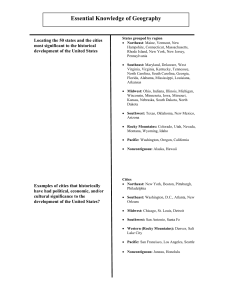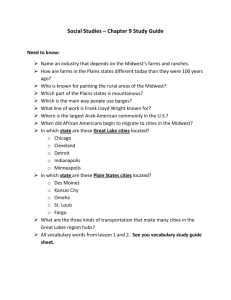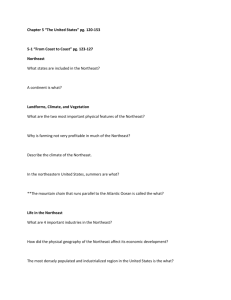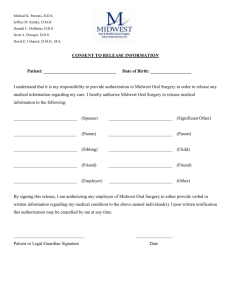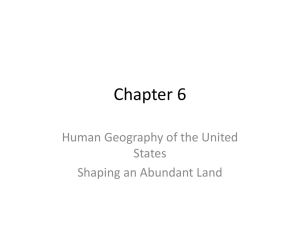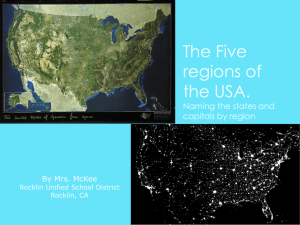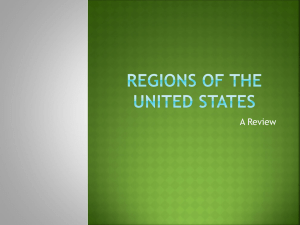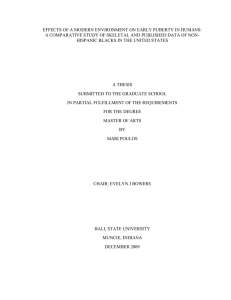United States of America
advertisement
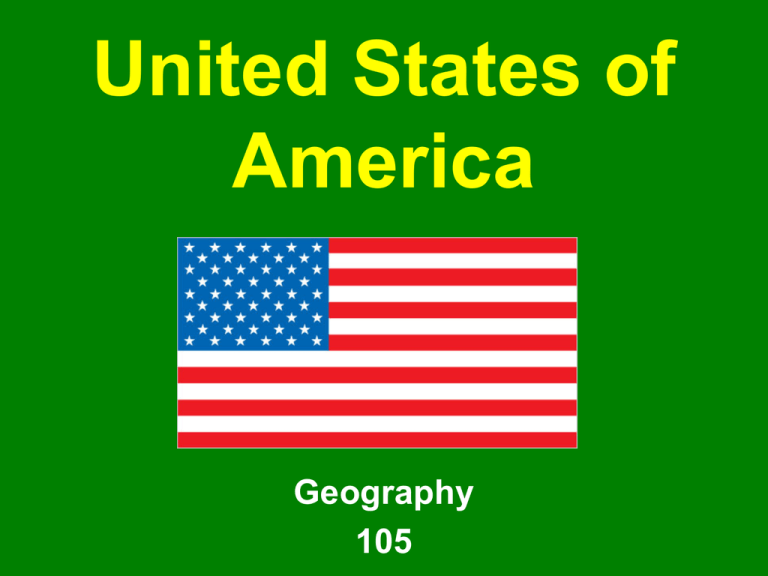
United States of America Geography 105 United States United States American Flag • Capital: Washington, D.C. United States • Population Growth Rate: 0.77 % (2014 est.) • Population: 318,892,103 (July 2014 est.) • Median Age: 37.8 years • Life Expectancy: 79.56 (42nd) • Ethnic Groups: White 79.96%, Black 12.85%, Asian 4.43%, Amerindian and Alaska native 0.97%, native Hawaiian and other Pacific islander 0.18%, two or more races 1.61% • Religion: Protestant 51.3%, Roman Catholic 23.9%, Mormon 1.7%, other Christian 1.6%, Jewish 1.7%, Buddhist 0.7%, Muslim 0.6%, other or unspecified 2.5%, unaffiliated 12.1% • Birth Rate: 13.42 births/1,000 population (2014 est.) • Infant Mortality Rate: 6.17 deaths/1,000 live births (2014 est.) United States Population Pyramid 5 The 50 United States United States Facts: • The United States has one of the highest natural growth rates (0.7%) of any industrialized country in the world. • The US population is growing by about 2.5 million people each year. • The US average fertility rate is currently 2.1 births per woman, an increase from 1.8 in 1988. • Nearly half of the population lives 100 miles of the coasts. • Since 1980, the US has converted more than 10 million acres of forest to suburb. • 16.2% of U.S. GDP goes to health care expenditures. 2010 United States Population Density Map United States Population Pole Map United States Facts Population by Sex and Selected Age Groups: 2000 and 2010 We're Number One !!!! • #1 in Billionaires (and No 1 in Children Living in Poverty) • #1 in Health Care Absolute and Per Capita Expenditures (and No. 15 in Life Expectancy) • #1 in Total Health Spending (and No. 13 in Public Health Spending) • #1 in Wealth and Income Inequality and No 16 in Percentage of Total Income Held by Poorest 40% of the Population • #1 in Percentage of Population without Health Care Coverage • #1 in Teenage Pregnancy and No 1 in Teenage Mothers under 14 Years Old • #2 in Cigarette Consumption and No 4 in Alcohol Consumption per Capita • #1 in Defense Spending and No 19 in Spending on the Poor, the Aged, and the Disabled • #1 in Number of people killed in car accidents due to drunk driving United States Facts • The center of the U.S. is in the town of Castle Rock, South Dakota. • Alaska has a longer coastline than all the other 49 states put together. • The first US capital was New York City. • California grows more food than any other state. • Boulder, Colorado is the only city in the U.S. to own a glacier. • The United States has more roads than any other country in the world. United States Interstate Map 2005 Infant Mortality Rate: U.S. vs. The World 2005 Infant Mortality Rate: U.S. Ethnicity United States Physical Map United States Topographic Map Time Zones of the United States Regions of the United States “Perceptions” of the United States Regions of the United States Northeast Region of the United States Northeast United States New England: Connecticut, Maine, Massachusetts, New Hampshire, Rhode Island and Vermont Mid-Atlantic States: New Jersey, New York and Pennsylvania Northeast States Facts • The northeast U.S has the highest population density with the United States. • This location was one of the earliest parts to be settled by the Europeans. • 1497 Giovanni Caboto (John Cabot) lands on the New England mainland and claims it for the king of England. • Washington D.C., which is not a US state, is also considered part of the Northeast region. • Land value is one of the highest in this region. • Though lacking a unified cultural identity, the Northeastern region is the nation's most economically developed, densely populated, and culturally diverse. Northeast States Facts • The geography of New England is very rough. • Its coastlines are very rough and has many bays. • The region extends from the coast to inland plateaus and mountains. • Inland, it has tall mountains and rough soil, not good for farming. • It is moderately hot in summer and cold in the winter on the northern part of the United States. • Region is prone to storms induced by proximity to Atlantic Ocean. • As of 2007, forest-use covered approximately 60% of the Northeastern states (including Delaware, Maryland, and the District of Columbia), about twice the national average. Northeast States Physical Map United States Precipitation Map United States Temperature Map United States Temperature Map Midwest Region of the United States Midwestern United States East-North Central: Wisconsin, Michigan, Illinois, Indiana, Ohio West-North Central: Missouri, North Dakota, South Dakota, Nebraska, Kansas, Minnesota, Iowa Midwest States Facts • Starting in the early 1800s easterners moved there in search of better farmland. • The region's fertile soil made it possible for farmers to produce abundant harvests of cereal crops such as wheat, oats, and corn. • Known as the nation's "breadbasket." • The Midwest gave birth to one of America's two major political parties, the Republican Party, which was formed in the 1850s to oppose the spread of slavery into new states. • Most of the Midwest is flat. • The Mississippi River has acted as a regional lifeline, moving settlers to new homes and goods to market. • The Midwest has the highest rate of life expectancy. United States Farming Map Midwest States Facts • The Midwest is a cultural crossroads with may Europeans bypassing the East Coast to migrate directly to the interior. • The culture of the Midwest is generally acknowledged to be "down to earth". • The "Midwestern Accent" is the voice most commonly heard on national newscasts across the country. The “Rust Belt” 2011 Male Life Expectancy Map 2011 Female Life Expectancy Map Midwest Physical Map The Corn Belt Plant Hardiness of the United States Great Plains: A broad expanse of flat land, much of it covered in prairie, steppe and grassland, which lies west of the Mississippi River and east of the Rocky Mountains in the United States and Canada. 100th Meridian The 100th Meridian roughly corresponds with the line which divides the Great Plains into an area that receive 20” or more of rainfall per year and an area that receives less than 20”. Tornado Belt Map Southern Region of the United States Southern United States South Atlantic: Delaware, Maryland, District of Columbia, Virginia, West Virginia, North Carolina, South Carolina, Georgia, Florida Southern United States East-South Central: Kentucky, Tennessee, Mississippi, Alabama West South Central: Oklahoma, Texas, Arkansas, Louisiana Southern States Facts • The Southern United States—commonly referred to as the American South, Dixie, or simply the South. • Historically, the South relied heavily on agriculture, but has become more industrialized and urban since the second half of the 20th century, attracting national and international migrants. • Eight Southern states have the highest obesity rates in the country : Mississippi, Alabama, Arkansas, Kentucky, Louisiana, Oklahoma, Tennessee, and West Virginia. • Life expectancy is lower and death rates higher in the South than in the other regions of the country for all racial groups. • The south is home to the Mason-Dixon line. The Mason–Dixon Line The Mason–Dixon Line symbolizes a cultural boundary between the Northeastern United States and the Southern United States (Dixie) and legality of slavery. Southern United States Physical Map Western Region of the United States Western United States Mountain: Idaho, Montana, Wyoming, Nevada, Utah, Colorado, Arizona, New Mexico Pacific States Pacific: Alaska, Washington, Oregon, California, Hawaii Western States Facts • The Western states are usually mountainous and rocky. • The Rocky and Cascade mountain ranges collect a large part of the airborne moisture moving in from the ocean. • The Rocky Mountains are North America’s largest mountain chain. • The climate of the West can be described as overall semiarid. • Parts of the West get extremely high amounts of rain and/or snow, and still other parts are true desert and get less than 5 inches of rain per year. • The Pacific States are the most geologically active areas in the United States with both earthquakes and volcanoes. Western United States Physical Map United States Fault Line Hazard Index Western States Facts • The West is still one of the most sparsely settled areas in the United States with 49.5 inhabitants per square mile. • The Western region has the highest percent of Hispanic population. • Agencies of the federal government own and manage vast areas of land for the purpose of conservation and National Parks. • The west is home to “Silicon Valley.” • Kilauea Iki, in Hawaii, is the world's most active and largest volcano. • Alaska is the largest state in the United States. Hispanic or Latino Population as a Percent of Total Population by County: 2010 American Indian, Eskimo, and Aleut Population as a Percent of Total Population by County: 2010 Source: U.S. Bureau of Labor Statistics 2012 United States by State: Unemployment Rate 2012
